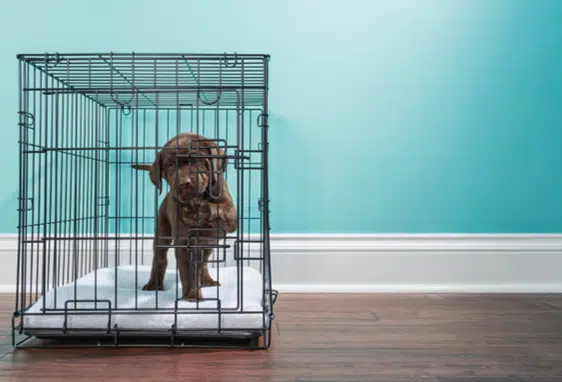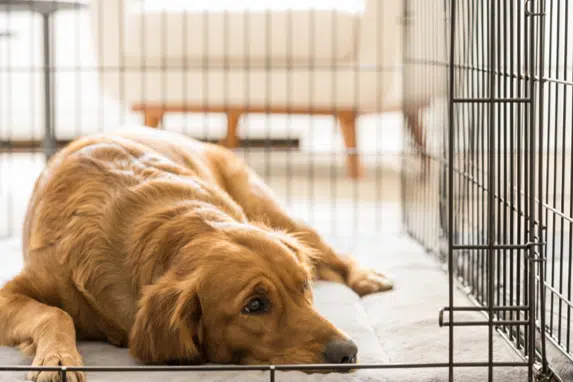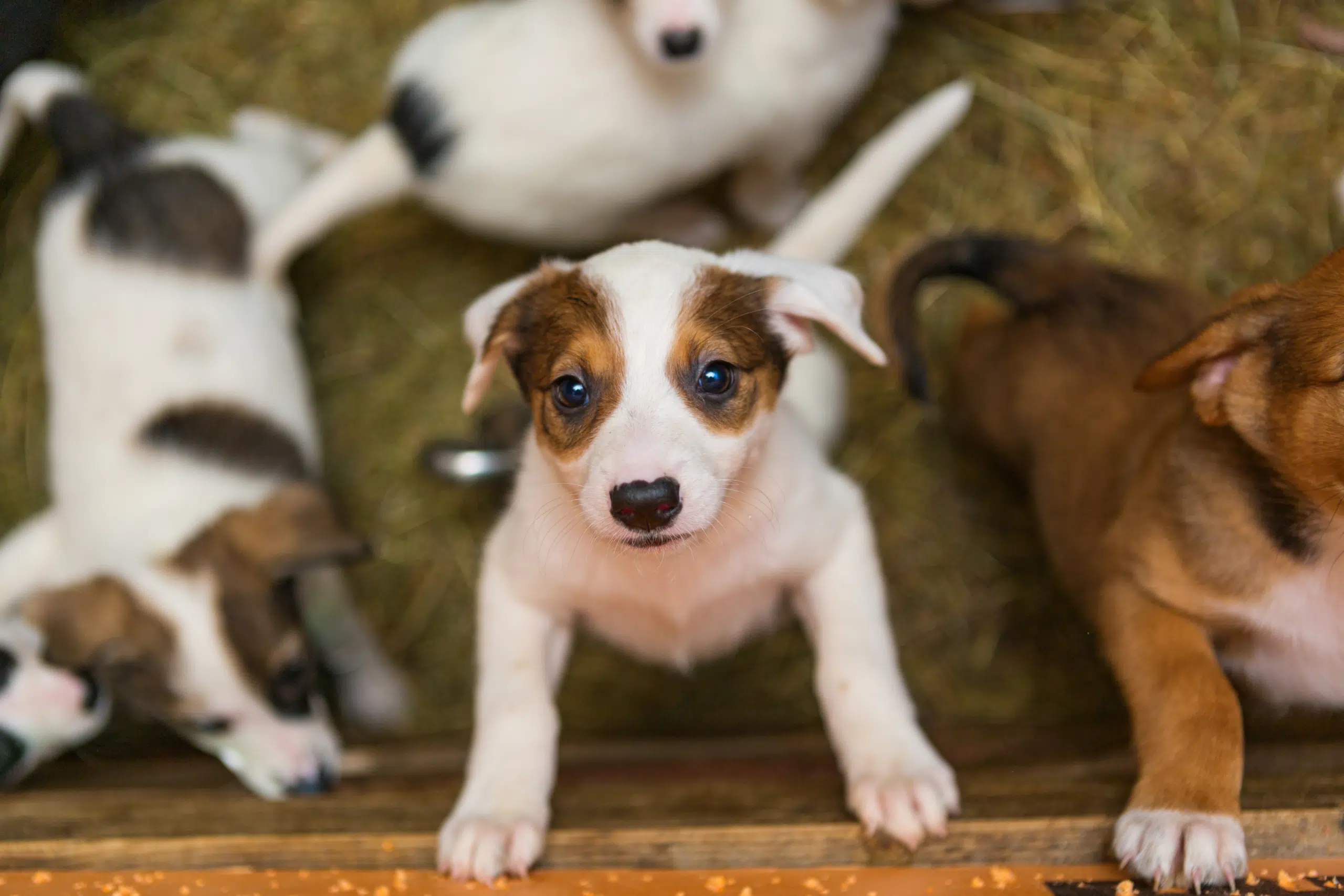Crate training two puppies simultaneously presents a unique set of challenges and opportunities for pet owners. In this comprehensive guide, we’ll provide essential tips and a step-by-step process to successfully crate train both puppies, ensuring harmony and effective training in your household.
Introduction to Crate Training Two Pups
Crate training two puppies might seem like a delightful challenge, but it’s essential to understand the intricacies and training process involved. The complexity of this task is often underestimated, leading many pet owners down a path filled with unforeseen challenges.
Crate training is like giving your dog its little room. It’s a special space where they can relax and feel safe, just like you have your own bedroom. Although it is such a small space, think of it as your dog’s bedroom! It helps them learn when to go potty outside and keeps them safe when you can’t watch them.
Crate Training: A Quick Summary
Crate training is a method of dog training that involves using a crate or kennel to create a safe, personal space for a dog. This method is based on the natural instinct of dogs to seek out a den-like space. When done correctly, the crate becomes a secure environment where the dog feels safe and comfortable.
Here are some key points about crate training:
- Purpose: The primary purpose of crate training is to provide a dog with a familiar, safe space where they can relax. It’s also a valuable tool for house training, as dogs typically avoid soiling their sleeping areas.
- Housebreaking: For puppies, crate training can be an effective method for housebreaking and potty training. Puppies usually don’t like to soil their sleeping areas, so they’ll try to hold it until they’re let out of the crate. This teaches them to control their bladder and establishes a routine for potty breaks.
- Safety: A crate can keep a dog safe when you can’t supervise them, preventing them from getting into potentially dangerous situations or ingesting harmful substances.
- Travel: Crates provide a familiar environment for dogs when traveling, making trips less stressful for them.
- Recovery: If a dog is recovering from surgery or an injury, a crate can help restrict their movement, ensuring a safe and speedy recovery.
- Training Approach: It’s essential to ensure that the crate is always associated with positive experiences. It should never be used as a form of punishment. The goal is for the dog to view the crate as a comforting, personal space.
- Size: The crate should be large enough for the dog to stand up, turn around, and lie down comfortably, but not so large that they might designate a corner for potty.
The Intricacies and Challenges of Training Two Puppies
Training two puppies simultaneously is a journey filled with both joy and challenges. The allure of adopting and having two furry companions growing up together is undeniable, but the path is strewn with potential pitfalls. Being well-informed about these challenges is the key to navigating this journey successfully.
Click here for more information on dog training 101.
The Importance of Using Two Crates in Puppy Training
When embarking on the journey of crate training two puppies, the importance of using two crates cannot be overstated. Puppies, much like humans, require their own space to feel secure and develop a sense of independence. By providing each puppy with its own crate, you are fostering an environment where each dog can develop at its own pace, minimizing the risks of anxiety and territorial behaviors.
The use of individual crates promotes healthy boundaries and allows each puppy to establish its own safe haven, essential for their well-being and development. This is paramount in avoiding resource guarding and other behavioral issues that may arise when puppies feel the need to compete for space or resources. While shared toys or training aids can be beneficial, essentials like crates should remain individualized, ensuring each puppy has its personal sanctuary.
Double The Trouble: Dual Crate Training:
At first glance, training two puppies might seem like double the fun, but in practice, it often translates to double the effort and potential complications. Each puppy is a unique individual, with its own temperament, learning curve, and quirks.
Dual crate training is not just about managing two puppies but understanding their individual personalities. For instance, while one puppy might take to the crate immediately, finding it a safe haven, the other dog might be more apprehensive, requiring additional comfort and assurance.
The Imperative of Individual Attention:
Treating the puppies as two halves of a whole is a common mistake. While they might be siblings, they are individual beings with distinct needs, desires, and fears.
Activities that promote individual growth are crucial. For example:
- Separate Training Sessions: While some dogs might excel at fetch, other dogs might be more inclined towards scent games. Tailoring sessions to their strengths can boost their confidence.
- Distinct Playtimes: Playing with them separately not only strengthens your bond with each but also allows them to explore and enjoy games without the shadow of their sibling.
- Individual Walks: This ensures that each puppy gets to explore the world at their own pace, sniffing out new trails and making new friends.
As PetMD points out, even small steps, like ensuring each puppy has its own set of toys or feeding them in separate bowls, can make a significant difference in fostering their individual identities.
Delving Deeper: The Benefits of Crate Training Two Dogs Together
Training a pup or two puppies simultaneously might seem like a monumental task, but with the right approach, the puppy training rewards can be equally significant. Crate training, a cornerstone of dog training, offers a plethora of benefits, especially when you’re nurturing two young canines.
Building a Bond Between the Puppies:
Witnessing the bond between two dogs is nothing short of magical. This bond, nurtured correctly, can lead to a harmonious household and a lifelong friendship between the pups.
DogTime elaborates on how crate training can be a catalyst for this bond. By undergoing shared experiences like crate training, puppies learn to read each other’s signals, respect boundaries, and even develop synchronized routines. Imagine the two puppies signaling each other when it’s bedtime or alerting the other if they hear a peculiar sound.
However, moderation is key. While shared experiences in the crate can foster camaraderie, it’s paramount to ensure each puppy has its individual moments of solitude and relaxation.
Efficient Use of Time and Resources:
One of the overlooked advantages of training two puppies together is the efficiency it brings to the table. Instead of duplicating efforts, certain training exercises can be combined, leading to a cohesive learning experience.
Toys, training tools, and treats can be maximized for dual training. For instance, a tug toy can be used to teach both puppies about taking turns, instilling patience and discipline in a playful manner.
Navigating the World of Crate Training: Comprehensive Steps and Insights for Two Puppies
Crate training, while beneficial, is a nuanced process, especially when dealing with two puppies. The dynamics, challenges, and rewards are manifold. To ensure a smooth and positive experience, it’s essential to delve deep into the practicalities and understand the intricacies involved. Here are some helpful tips to help you navigate this journey.
Choosing the Right Crate Size and Environment:
The crate’s size is of utmost importance. It should offer enough room for the puppy to stand, stretch, turn around, and lie down without feeling cramped. However, an overly spacious crate might give them the idea to use a corner as their restroom.
Location, Location, Location! The crate’s placement plays a pivotal role in the puppy’s comfort. While it should be in a calm spot, it shouldn’t be isolated. Ideally, it should be within the family’s primary living area, ensuring the puppies feel connected while having their tranquil space.
Introducing Puppies to the Crate: A Step-by-Step Guide:
- Familiarization: Begin by keeping the crate door open and placing enticing toys or treats inside. Allow the puppies to explore without any pressure.
- Meal Times: Feed them inside the crate, creating a positive association with the space.
- Short Durations: Start with short durations inside the crate, gradually increasing the time as they get accustomed.
- Nighttime Routine: Encourage them to sleep in the crate, establishing it as a restful place.
- Positive Reinforcement: Always reward them for entering the crate, reinforcing the idea that it’s a positive space.
Setting a Consistent Routine:
Puppies thrive on routine. This encompasses:
- Feeding: Regular feeding times inside the crate.
- Play: After a play session, guide them to the crate for some downtime.
- Rest: Designate specific “quiet times” during the day when they can retreat to their crate for relaxation.
Predictability fosters trust. The more structured their day, the easier it becomes for them to adjust to the crate.
Addressing Common Issues and Ensuring Comfort:
Like any training, crate training comes with its set of challenges.
- Separation Anxiety: If one puppy is taken out, the other might exhibit signs of distress. Training sessions where they spend time apart can help alleviate this.
- Territorial Behavior: If one starts to display dominance over the crate, consider separate training sessions or even separate crates.
- Comfort Measures: Soft bedding, a familiar toy, or even a piece of clothing with your scent can make the crate more inviting.
The American Kennel Club offers a plethora of resources on these challenges, emphasizing the importance of patience, understanding, and positive associations. The crate should always be synonymous with safety and comfort, never punishment.
Crate training just one dog is a challenge, but multiple dogs is a journey that requires dedication, patience, and a deep understanding of canine behavior.
Addressing the Curiosities: Frequently Asked Questions
As with any endeavor, crate training two pups simultaneously brings forth a myriad of questions. These queries often stem from genuine concerns, misconceptions, or simply the desire to provide the best for your furry companions. In this section, we’ll address some of the most common questions to offer clarity and guidance.
Should Each Puppy Have Its Own Crate?:
This is one of the most frequently asked questions, and the answer is a resounding yes. While it might seem like a good idea to have them in the same crate, especially when they’re tiny, individual crates are crucial for their development.
Each puppy needs its own sanctuary, a place where they can retreat, relax, and feel safe. Having separate crates fosters independence and reduces potential conflicts. It is important for them to sleep separately
Moreover, as they grow, the space in a single crate can become cramped, leading to discomfort.
How Long Should Puppies Stay in the Crate?:
The duration varies based on the age of the puppies. Young puppies have limited bladder control, so they shouldn’t be crated for extended periods.
PetMD provides a handy guide on crate durations:
- 8-10 weeks old: 30-60 minutes
- 11-14 weeks old: 1-3 hours
- 15-16 weeks old: 3-4 hours
- 17+ weeks old: 4-5 hours (though it’s essential to ensure they get ample playtime and exercise outside the crate)
Remember, the crate is not a solution for leaving puppies unattended for long durations. It’s a tool for training and ensuring their safety.
How to Crate Train at Night Time?:
Nighttime crate training can be particularly challenging, especially during the initial days of crate training.
Puppies might feel anxious or scared. To alleviate this, ensure their crate is in a quiet place, free from disturbances. A soft toy or a piece of your clothing can provide comfort.
For the first few nights, you might consider placing the crates in your bedroom. The familiar sounds and your proximity can be reassuring. As they get accustomed, you can gradually move the crates to their designated spot.
Regular bathroom breaks are crucial, especially for younger puppies. Be prepared for some midnight outings until they can hold their bladder throughout the night.
Conclusion: Embracing the Journey of Dual Puppy Crate Training
Training two dogs simultaneously is undeniably a journey filled with its unique set of challenges and joys. From understanding the intricacies of their bond to navigating the practicalities of crate training, every step offers a learning opportunity. As we’ve explored in every essential part of this comprehensive guide, the key lies in patience, consistency, and a deep understanding of canine behavior.
Remember, every puppy, every litter, even siblings, have their unique personalities, quirks, and needs. By addressing these individualities and ensuring a structured, positive environment, you pave the way for successful crate training and a lasting bond.
The journey of raising two puppies, with all its ups and downs, is a beautiful adventure for family members that offers immeasurable rewards. Here’s to happy, well-trained pups and the joy they bring into our lives!
Interesting Reads:
Crate Training a Puppy at Night: A Guide for Peaceful Sleep











Get involved!
Comments